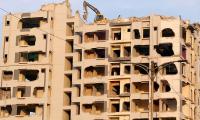KARACHI: Moody’s on Thursday said the fresh capital requirements set by the central bank for the big three banks will enhance the financial stability of Pakistan’s banking system.
Moody’s Investors service, in a report, said National Bank of Pakistan, Habib Bank and United Bank Limited will likely meet the new capital requirements’ condition set by the central bank last week.
It said all three banks would achieve the given target despite the recent increase in private-sector lending and the short-time frame for the implementation of the domestic systemically important bank (D-SIBs).
Last Thursday, the State Bank of Pakistan (SBP) designated three banks as domestic systemically important banks (D-SIBs). The D-SIBs are required to set aside additional Common Equity Tier 1 (CET1) capital relative to risk-weighted assets by March 2019 and will also be subject to enhanced supervisory requirements.
Moody’s said the three D-SIBs will also be subject to enhanced supervisory requirements that will strengthen their risk-management frameworks.
All three banks met the common equity Tier 1 (CET1) requirements by the 2019 yearend, including the D-SIB buffer as of December 2017, and “if the need arises they can also adjust their dividend payout ratios (as HBL and NBP did in 2017) and/or optimise their balance sheets to strengthen capital ratios and increase buffers over the regulatory minimum ratios”.
“Notwithstanding any idiosyncratic events that lead to erosion of capital buffers (e.g. NBP’s contingent liability), we expect that the three D-SIBs are well positioned to meet the additional 1.5 percent-2.0 percent D-SIB buffer,” Moody’s said.
The ratings agency said the D-SIBs’ enhanced requirements are credit positive because they will support overall banking system financial stability by strengthening the capital buffers and loss-absorption capacity of the country’s largest banks and will further develop their risk-management framework.
Moody’s rated HBL as B3 stable, caa11, National Bank of Pakistan B3 stable, caa1 and United Bank Ltd. B3 stable, b3.
Moody’s said all three banks are important to the country’s national payment system and any failure would have wide repercussions on the payment system and the economy.
Moody’s said the additional capital requirements will strengthen the D-SIBs’ capital buffers, which lag those of their Moody’s-rated domestic peers, and enhance their loss-absorption capacity at a time when all three face idiosyncratic pressures.
The ratings agency said HBL is recovering from a settlement payment of $225 million made to US authorities in third-quarter 2017 as it scales down its international operations because of increased compliance risks. NBP faces a significant contingent liability related to pension disputes (equal to roughly 20 percent of its March 2018 equity), which if it materialises will weigh on the bank’s capital buffers, it added.
Moody’s said UBL’s asset quality pressures in its international loan book (around a third of the total loan book) are ongoing and will likely lead to additional provisioning costs (1.15 percent of gross loans in first quarter 2018) as the bank builds up its coverage of overseas nonperforming loans.
It said these include preparing comprehensive risk-appetite frameworks and conducting macro stress tests that will be incorporated into the banks’ internal capital adequacy assessment process, establishing effective recovery plans commensurate with the size and complexity of the bank and enhanced engagement between senior management and supervisory authorities.
In this picture, the PCJCCI logo can be seen on September 1, 2022. — Facebook/Pakistan China Joint Chamber of...
A representational image of a US flag pictured alongside a street sign reading "Wall Street" in the New York city. —...
A security guard sits in front of a wall with signs and slogans at the operation building at the Pakistan Steel Mills ...
A worker cleans the entrance to the headquarters of Bank Indonesia, the nation's central bank, in Jakarta, Indonesia....
The MCB's logo is seen on a wall outside the bank's head office. — MCB websiteKARACHI: MCB Bank Limited on...
A foreign currency dealer counts US dollars at a shop in Karachi. — AFP/FileKARACHI: The rupee lost ground against...







